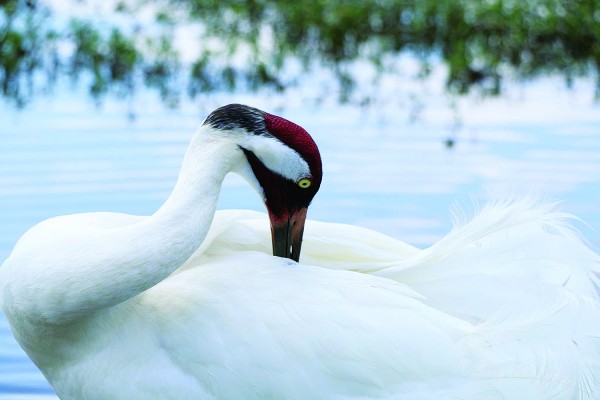Whooping crane dies after second surgery

L10-11, a whooping crane that had been nesting in Jeff Davis Parish for the past three years, died after a second surgery was performed to remove additional necrotic bone in his left wing from an injury he suffered in March.
The surgery went as planned; however, he stopped breathing after anesthesia was discontinued. The vet staff was unable to revive him.
“We actually don’t know what happened to him but he had some nerve damage and the injury was exposing the bone and turning necrotic, so the last part of his wing had to be amputated with the first surgery. When they examined it again, the healed area the on the skin was stretching too tight and the bone was exposed again and turning necrotic once more,” said Eva Szyszkoski, a wildlife technician with Louisiana Department of Wildlife and Fisheries (LDWF) Whooping Crane Project. “They had to put him under to remove a little more of the bone and the surgery went fine. He wouldn’t wake up after they stopped anesthesia, though, and they tried different methods to revive him for an hour but were unsuccessful.”
L10-11 was hatched in 2011 in captivity at the White Lake Wetlands Conservation Area in Gueydan as part of the Louisiana Whooping Crane Project and released there as well. He eventually paired and started nesting in Jeff Davis in 2016. He also nested here in 2017 and 2018, hatching one chick, LW3-17 with his mate L11-11.
“It was during this past spring when we noticed the wing injury. They were actually incubating when the injury occurred,” Szyszkoski said.
Szyszkoski said it is not totally unexpected for a bird to die or get injured in the wild. She said regardless, this crane would be missed and remembered for his aggressive nature.
“This crane was very aggressive when we had to visit the nest or capture one of the two. He was a pretty well-known crane and we liked him a lot because the aggressive nature is something we like to see in a crane,” she said. “That means they tend to have a better chance of surviving in the wild. He and his mate both had this trait.”
L10-11’s carcass will be sent to the USGS Wisconsin National Wildlife Health Center for examination to see if there was an underlying reason he stopped breathing after surgery, Szyszkoski said.
Szyszkoski said L11-11 is still in Jeff Davis Parish and should remain there. She should remain there unless she decides to move or other birds encroach on the area, but she and other wildlife technicians cannot be certain what she will do next.
In addition to L11-11, there are two families of cranes currently in Jeff Davis Parish, one consisting of three cranes and another consisting of four.
